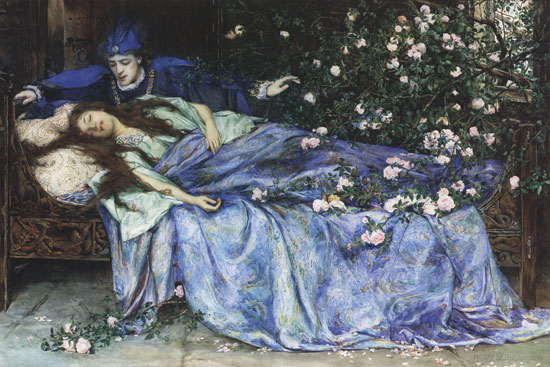
Image retrieved from: https://upload.wikimedia.org/wikipedia/commons/c/ce/Henry_Meynell_Rheam_-_Sleeping_Beauty.jpg
I'm sure there are many Disney kids out there who will remember the glamorous tales of Snow White, Cinderella and Sleeping Beauty, but how many of you have realised the underlying truths about these so-called fairy tales? Since the initial year these narratives were published, 1812 to be exact, these narratives have transmogrified from brutal and explicit reflections of German history and cultural identity, into tales of singing animals who help you in finding your true love. Now, with alterations this dramatic, I wouldn't blame you if were completely oblivious to the reality behind these narratives; heck, I'd be surprised if you were aware.
Narrative is an essential aspect of a person's understanding of the world and fundamentally, all history-telling is narrative (Kuttainen, 2015). Is it clear that when we read about historical events, we are enabled to understand and perceive what was happening in the world at a particular time; even if the material we are studying is fiction. Even though by popular belief, non-fiction is a more truthful representation of the world, fictional stories can reflect ways in which we visualise and experience the real world as non-fiction does. In regards to the Brothers Grimm, their folk tales reflected the gruesome events which took place in the 1800s; and while the term tale suggests otherwise, we are conscious that these narratives are not wholly fiction. Evidently, this notion of narrative demonstrates how different texts and discourses construct and appeal to those who value literature (Kuttainen, 2013).
This can also be seen in Instagram, however, as a social network, material that is highly valued differs from what's valued in the real world. “Talk is an integral part of the process of construction” (Tuan, 1991, p. 684). Instagram users are open to give and receive comments that show appreciation for another user's posts. These comments, which can be viewed by a large audience, or talk, therefore shapes and influences the ideal feed. Regardless, the ability to post a stabilised record of our history empowers us in the way we can create our desired self-image and influence the perceptions of other users.
References
Kuttainen, V. (2015). BA1002 Our Space: Networks, Narratives and the Making of Place. Lecture 5: Stories and Places. Retrieved from: https://learnjcu.edu.au
Kuttainen, V. (2013). Style, modernity and popular magazines. In T. Dalziell and P. Genoni (Eds.). Telling Stories: Australian life and literature 1935-2012). Victoria, Australia: Monash University Publishing
Tuan, Y. F. (1991). Language and the Making of Place: A Narrative-Descriptive Approach. Annals of the Association of American Geographers, 81 (4) pp. 684-696. Retrieved from: https://learnjcu.jcu.edu.au/webapps/Conc-camcontent-bb_bb60/items/getitem.jsp?as_course_code=14-BA1002-TSV-INT-SP2&content_id=_1631890_1&course_id=_60553_1&doc_id=30163
Truth. What is it? I enjoyed reading your blog because it raised the idea of fact and myth, something that I found very captivating in the lecture this week. According to Kuttainen (2015) fairy tales reflect ways of seeing and knowing the world. So, in this sense, we can see that the line between fact and myth becomes blurred. One person’s myth may be another person’s fact. What one believes is fact and myth depends on their environment: cultural, socio-economic, religion, etc. For example, a teenage girl in America may have an entirely different ontology to a teenage girl in Saudi Arabia. This is due to external factors influencing the way they perceive the world.
ReplyDeleteAn interesting concept from Chatwin (1987) relates to this idea of truth and knowing being subject to an individual’s experience: “to exist is to be perceived” (p. 14). What we believe exists is actually just a perception of its existence. This means that everything that we perceive to be true and factual may in the future be discussed as myth or fiction.
References:
Kuttainen, V. (2015). BA1002: Our space: networks, narratives and the making of place, week 5 notes [PowerPoint slides]. Retrieved from www.learnjcu.jcu.edu.au
Chatwin, B. (1987). The Songlines. London. Retrieved from www.learnjcu.jcu.edu.au
Fiction can hold a great deal of facts and a crystal clear image of the world. Writers can only base things off stuff they already know to be true. Many books and works of fiction can also be allegories, such as Animal Farm by George Orwell. Just because something is titled fiction doesn’t mean it’s full of lies or based off complete nonsense. As Victoria Kuttainen (2015) has said, narrative is fundamental in creating a community or identity. Much like how a space only becomes a place when there are emotions and memories attached to the area.
ReplyDeleteThe networking site Instagram is very similar in the sense that we create images that are beneficial to our image, or that are appropriate for the time we are in. Whether it be the selfie on New Year’s Day, or the punnet of ice-cream sitting next to you and Netflix on Valentine’s Day, unless you have a date. We create appropriate images for the times we are in.
References:
Kuttainen, V. (2015). BA1002: Space: Networks, Narratives, and the making of place, week 5 notes [PowerPoint slides]. Retrieved from https://learnjcu.jcu.edu.au